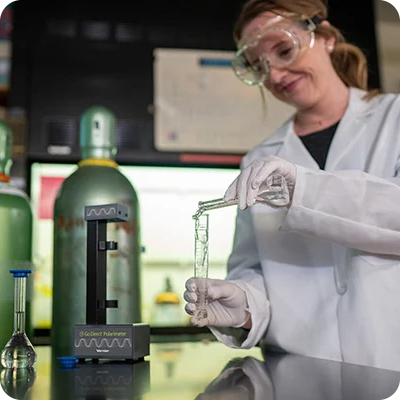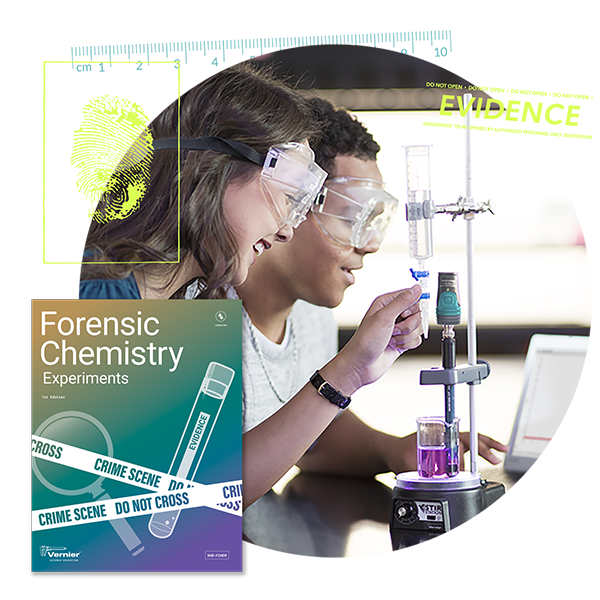
ACS Fall 2024
August 18–22
Denver, Colorado
Discover how Vernier Science Education can enhance your students' hands-on chemistry learning experiences
Visit us at booth 1013!
Inspiring the Chemists of Tomorrow,
One Experiment at a Time
About Us
Vernier chemistry experts Melissa Hill, PhD, and Jack Randall will be at booth 1013. They look forward to answering your questions, discussing chemistry offerings from Vernier, and helping you determine the best tools for your laboratory!
When you teach with Vernier, you’re teaching with a complete chemistry solution. From titrations to spectroscopy, our sensors and instrumentation are backed by powerful analytical software, college-level experiments, and unparalleled support.

Green chemistry focuses on safer, sustainable chemical processes by reducing hazardous substances and improving resource efficiency.
With innovative experiments from Vernier, you can easily incorporate green chemistry principles into your instruction, engaging students with eco-friendly, hands-on activities that reduce waste, use safer chemicals, and promote energy efficiency.

Free Experiments
Unleash the power of sustainable science in your classroom with Vernier's latest green chemistry experiments.
- “Titrating Towards Sustainability: A Green Chemistry Approach to Conductometric Analysis”
- “Eco-Friendly Precision: Standardizing Vinegar through Green Chemistry Titration”
- “Sustainable Spectroscopy: Analyzing Sports Drinks with Beer's Law in a Green Chemistry Lab”

Green Chemistry Webinar Video
Watch Vernier chemistry experts Dr. Melissa Hill and Nüsret Hisim guide you through a conductometric titration using ammonia and vinegar. This eco-friendly experiment aligns with green chemistry principles and introduces a fresh approach to titrations using Vernier technology.
Presentation Room Location
Room 407 - Colorado Convention Center
Date/Time
Tuesday, August 20, 2024 from 4:15 PM – 4:35 PM

As the desire to engage general chemistry students with practical, everyday applications grows, food chemistry—the analytical, biochemical, and chemical study of food and its ingredients—is an attractive candidate. One key aspect of food chemistry explored in this presentation is sugar reactivity. Sugar undergoes three primary reactions: Maillard, caramelization, and inversion. This presentation specifically highlights the use of polarimetry to study inversion. Sucrose inversion, catalyzed by the enzyme invertase, is particularly significant in food manufacturing as it yields inverted sugar—a sweeter, less-prone-to-crystallization mixture of glucose and fructose. This experiment provides students with hands-on experience elucidating the role of enzymes in food production while reinforcing essential chemistry concepts.
Go Direct Polarimeter
The concept of chirality can be difficult for students to visualize. The Go Direct Polarimeter provides a visual representation of this concept by measuring the optical rotation of optical isomers such as sugars, amino acids, and proteins. The Go Direct Polarimeter is simple to use, includes free, downloadable experiments, and is supported by the free Vernier Instrumental Analysis® app.
$545
Food Chemistry Experiments
Food Chemistry Experiments has 14 experiments
that use food as a means to explore crucial
chemistry concepts.
$41
Forensic Chemistry Experiments
Each of the 15 experiments in this book kicks off with a case study designed to engage high-school and college-level chemistry students. Immerse them in the excitement of solving fictitious crimes through hands-on experimentation using Vernier sensors such as pH, pressure, conductivity, and temperature to investigate complex questions involving forensics.
$41
Go Direct Mini GC™
Teach students chromatography with this affordable, portable gas chromatograph, which uses a unique carbon-nanotube chemiresistance detector to measure both polar and nonpolar compounds. Check out our short video demo.
$3,599
Go Direct Cyclic
Voltammetry System
With the Go Direct Cyclic Voltammetry System, developed in part with Pine Research (specialists
in electrochemical research instrumentation),
students can easily control and apply potential to
a chemical system and measure the response as electrical current.
$999
Spectrometers
Save time and space with our suite of
easy-to-use spectrometers.
Save time and space with our suite of spectrometers. These innovative, easy-to-use instruments have
a small footprint and collect data within seconds
with our free Vernier Spectral Analysis® app.
Our spectrometers offer a robust set of
capabilities, including
-
Full spectrum analysis of samples in seconds
-
Beer’s law analysis (e.g., absorbance vs. concentration)
-
Kinetics experiments (e.g., absorbance vs. time)
-
Various modes of data collection (absorbance, %transmittance, fluorescence, and emissions)
Go Direct Salinity Sensor
This sensor measures temperature-compensated
or non-temperature-compensated salinity and temperature in aqueous solutions ranging from brackish to hyper-saline environments, allowing for the determination of total dissolved salt content.
$180
Go Direct Melt Station
Teach students the visual detection capillary method of melting point determination with the Go Direct Melt Station. It accurately measures melting temperatures of a solid (up to 260°C), and real-time graphing provides a unique perspective of the melting process.
$599
Resources
Your peers and friends are already fans of Vernier! Check out our recent mentions in major chemistry
education publications.
“Mixing Chemistry and Art: Exploring Azeotrope Mixtures Used to Clean Paintings in Art Conservation” William Villarreal, Megan Hicks, Jorge De La Cerda, Gregory D. Smith, Adrian Villalta-Cerdas; The Chemical Educator; 29, 101–109 (2024).
“Undergraduate Laboratory Project Comparing Two Analytical Techniques for Ascorbic Acid Determination” H. Y. Samayoa-Oviedo and J. Laskin; Journal of Chemical Education; 99, 4043 (2022).
“Evaluating the Heats of Combustion of Coals Using Bomb Calorimetry in the General Chemistry Laboratory” A. M. Ranjika and P. Bopegedera; Journal of Chemical Education; 100, 298 (2023).
“Research-Focused Approach for Introducing Undergraduate Students to Aromatic Organic Synthesis at a Community College” J. T. Boette, K. M. Daniel, J. W. Lietzke, S. M. Amorde, and S. T .Roberts; Journal of Chemical Education; 100, 572 (2023).
We are chemists, educators, and your team.
As you implement data-collection technology into your teaching, we’re here to support you! Looking to learn more about our chemistry products or have questions about ordering? Reach out to our team.

Melissa Hill, PhD
Chemistry Staff Scientist
"I really appreciated that Vernier is very supportive of schools. Your customer service is excellent, and we are very happy to use Vernier products in our labs."
Joy Nguyen
California State University, Monterey Bay








